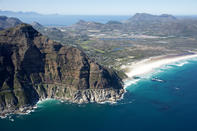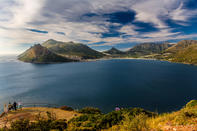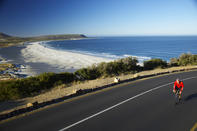All-Time Favourite Drive
Chapman’s Peak is an all-time favourite drive. Unsurprisingly, the road pass was very difficult to build, and the 9 km road was only completed in 1922, nearly 10 years after it was first proposed. The reasons for the delay were obvious; this was a steep and rocky mountain, and a dispute over the routing didn’t make things any easier. Some people wanted the road to go over the summit, while others wanted to make a lateral cut into the cliffs. Finally, the latter option was chosen and a track was hacked into the sheer mountain face, under the supervision of Robert Glenday.

And so this plucky little road now runs suspended between the high peaks and the sea below; balanced on a narrow ledge formed by the transition zone between a layer of Cape Granite and the sedimentary rocks of the Graafwater Formation immediately above. This original route was both a miraculous piece of engineering and a scenic masterpiece to boot. Once it was completed, Chapman’s Peak quickly gained a reputation as a day drive of extraordinary appeal.
The pass begins on the eastern side of Hout Bay. At the foot of the pass, there is a bronze statue of a leopard sculpted by Ivan Mitford-Barberton in 1963. The statue is a little tribute to the Leopards who used to live in the area as recently as the 1930’s. Elephants were also common in the Hout Bay Valley, but the last two were shot way back in the 1830’s.
After this melancholy monument to Wildlife Past, Chapman’s Peak Drive continues past the little inlet of Flora Bay and through the new toll booth, currently charging around R47 per car. Then, the road starts to climb in a slow, rising arc that curves up from the Bay, hugging the mountainside.
Stunning Views

At the summit of the climb, there is a parking area where you can stop for an eye-filling view of the Sentinel (or Hangklip), Karbonkelberg, Little Lions Head, the Back Table and Chapman’s Peak itself; the unbroken bowl of mountains which forms a protective cup around the beautiful Bay of Wood.
For a few bleak years, this is where the road ended, as a number of serious rock falls forced the council to close the pass in 2000. The fate of the old road seemed uncertain, and residents of Hout Bay had to make do with Constantia Nek and Victoria Drive as their only links to the outside world. Thankfully, a remarkable rehabilitation project was completed in 2003 and a safer Chapman’s Peak is now, once again, open to traffic.
Rock Falls

You can continue as the road cuts through a jutting spur, swings to the left and runs at a slight decline along a precipitous cliff face that plunges straight down to the sea. The vista is extraordinary, as you drive along the formidable wall of rock, suspended between the sky and the deep blue sea. There can be few other roads in the world to compete with Chapman’s for unadulterated visual drama (although the Big Sur highway along the Californian coast does comes close). Then, all too soon, the last thrusting promontory is rounded and the road calmly descends to the charming village of Noordhoek.
In the old days, Chapman’s Peak Drive was entirely exposed on the cliff face, largely following the original route staked out in 1915. In 1999, however, a fire along the top of Chapman’s Peak destroyed much of the vegetation that was holding the soil together, and rock falls started becoming frequent. One such rock fall tragically killed a motorist and, in early 2000, the pass was closed and redesigned at considerable cost.
The new, improved road is now cut into the mountain’s face, tucked away in a half-tunnel treated to look like rock. Dozens of huge chain nets have also been suspended above the road, like giant baseball-mitts, to catch the tumbling boulders. While this renovation has been accomplished with great skill and sensitivity, one can’t help but think that the new road lacks some of the visceral impact of the old pass. But it’s still an awesome drive to have at our disposal, and it’s good to have Chapman’s Peak back.
 Lying at the south-western tip of Africa, the Cape Peninsula is on the Atlantic side of South Africa. A spectacular view of the Cape Peninsu...
Lying at the south-western tip of Africa, the Cape Peninsula is on the Atlantic side of South Africa. A spectacular view of the Cape Peninsu... The Cape Peninsula is shaped like a claw, curving out into the sea between Table Bay and False Bay. It is a magnificent headland, with extra...
The Cape Peninsula is shaped like a claw, curving out into the sea between Table Bay and False Bay. It is a magnificent headland, with extra...